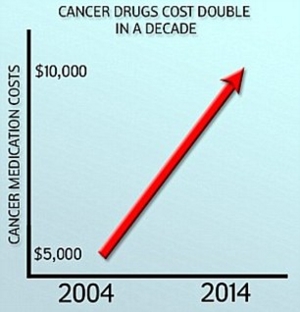 Cancer drug prices have doubled in the past decade, from an average of $5,000 per month to more than $10,000.
Cancer drug prices have doubled in the past decade, from an average of $5,000 per month to more than $10,000.
Eleven of the 12 cancer drugs the Food and Drug Administration approved for fighting cancer in 2012 were priced at more than $100,000 per year, double the average annual household income.
Thousands of cancer patients, even many with insurance, face the same dire decision: Go bankrupt or die.
Many are struggling with a huge jump in the average price tag for branded oncology treatments, which have doubled to $10,000 per month in just a decade.
That jump is contributing to a surge in global spending on oncology treatments, which reached a whopping $91 billion last year, according to a new report from the IMS Institute for Healthcare Informatics.
The U.S. is the largest segment of that market, with American patients and their insurers paying $37.2 billion for oncology treatments in 2013.
Pharmaceutical companies say it costs on average more than $1 billion to research a new drug and bring it to market, but critics put the costs at less than $90 million.
Last year 100 cancer specialists suggested that drug prices of $100,000 or more for treatments could be viewed as profiteering and may be causing financial harm to patients.
The pharmaceutical industry is the second most profitable industry in the United States, after the oil and gas industry.

Rising costs: Cancer patients are more than two times as likely to file for bankruptcy compared with Americans without a cancer diagnosis
The top-tier cancer drugs cost twice as much in the United States as they do in parts of Europe, China, Canada and the United Kingdom, where the government sets a limit on pricing and medications are as much as 38 percent lower.
As the cost of the pills have more than doubled since 2007, the CEOs of the drug companies have earned tens of millions of dollars.
The companies justify the enormous spend by pointing out the research needed to develop them and the scientific innovation they represent along with thevalue they deliver to patients and physicians.
However, nearly one in five cancer patients can’t afford their medication and even with insurance many are on the hook for covering 20 percent of their drug payments.
The study also found that patients were less likely to persist with treatment as the costs climbed.
There is some positive news however, Cancer survival rates are climbing, with 20 percent of the improvement due to advances in treatment.
The top-tier cancer drugs cost twice as much in the United States as they do in parts of Europe, China, Canada and the United Kingdom, where the government sets a limit on pricing and medications are as much as 38 percent lower.
As the cost of the pills have more than doubled since 2007, the CEOs of the drug companies have earned tens of millions of dollars.
The companies justify the enormous spend by pointing out the research needed to develop them and the scientific innovation they represent along with thevalue they deliver to patients and physicians.
However, nearly one in five cancer patients can’t afford their medication and even with insurance many are on the hook for covering 20 percent of their drug payments.
The study also found that patients were less likely to persist with treatment as the costs climbed.
There is some positive news however, Cancer survival rates are climbing, with 20 percent of the improvement due to advances in treatment.
Written by James Gordon and published by The Daily Mail, May 6, 2014.
FAIR USE NOTICE: This site contains copyrighted material the use of which has not always been specifically authorized by the copyright owner. We are making such material available in our efforts to advance understanding of environmental, political, human rights, economic, democracy, scientific, and social justice issues, etc. We believe this constitutes a ‘fair use’ of any such copyrighted material as provided for in section 107 of the US Copyright Law. In accordance with Title 17 U. S. C. Section 107, the material on this site is distributed without profit to those who have expressed a prior interest in receiving the included information for research and educational purposes. For more information go to: http://www. law. cornell. edu/uscode/17/107. shtml“
